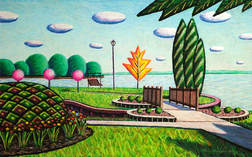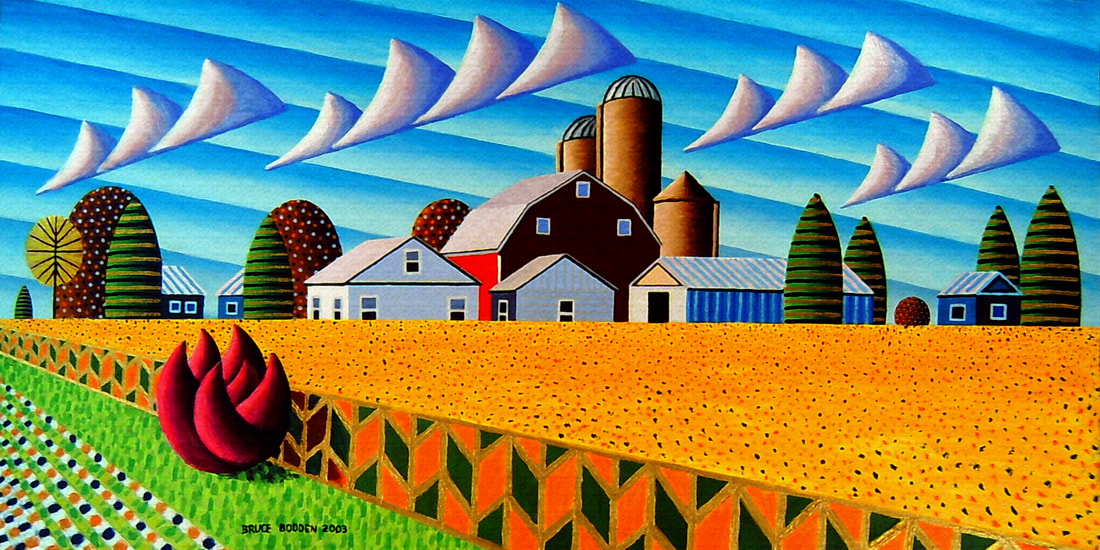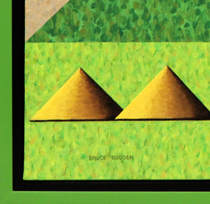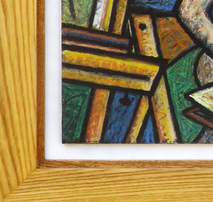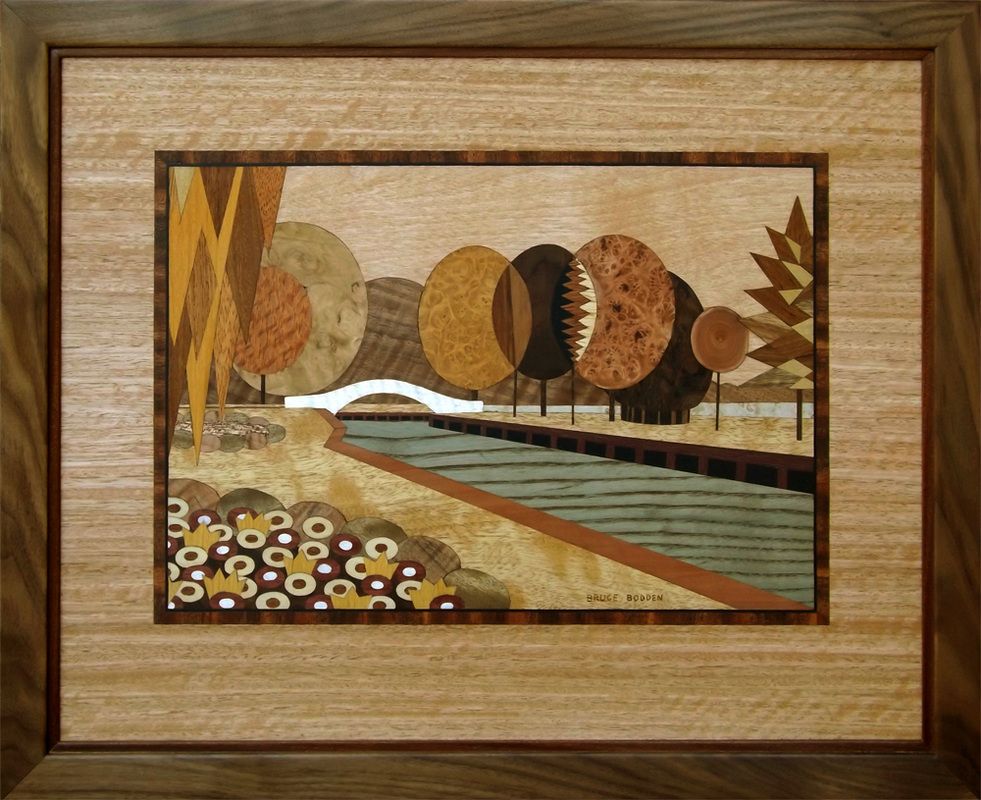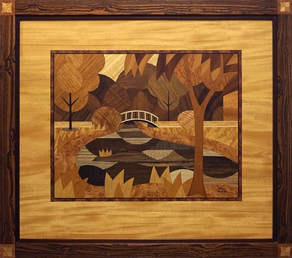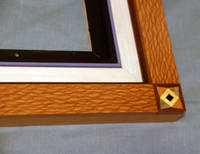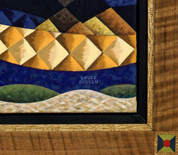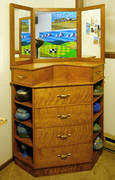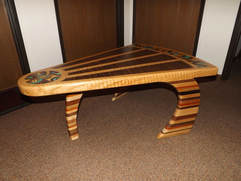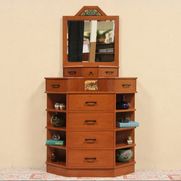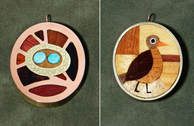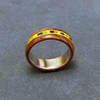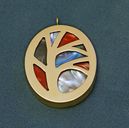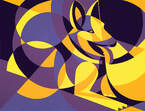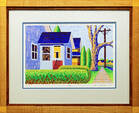When entering art fairs and shows, one part of the entry process that I have been annoyed with is that they mostly expect artists to fit into a single box or medium: Are you a painter or a drawer or a photographer or a jeweler etc. etc? It is like they are encouraging artists to pick just one medium to focus on, and seem to be discouraging artistic exploration into other areas. I believe an artist must be familiar with more than just one thing, because to make art that an artist can say is truly theirs requires different skills, like I will further explain.
I used to focus my efforts mostly in oil pastels, so I would enter shows in the Drawing category. But then I started to work in acrylics because I wanted to work larger and cleaner, so there was a conundrum: do I apply into the Drawing category or the Painting category? My style was consistent enough between the two so that it wasn't that big of a deal to enter one category or another because they looked similar, but I still felt like I was getting away with something that was against the interests of what the organizers of the art shows liked for artists to do. Sometimes I would have an oil pastel drawing that was the basis for a bigger or more developed acrylic painting...so both areas were completely necessary..so why do just one? I felt it was good to do both mediums or I would not be making my art the best that I felt it needed to be or could be done.
I used to focus my efforts mostly in oil pastels, so I would enter shows in the Drawing category. But then I started to work in acrylics because I wanted to work larger and cleaner, so there was a conundrum: do I apply into the Drawing category or the Painting category? My style was consistent enough between the two so that it wasn't that big of a deal to enter one category or another because they looked similar, but I still felt like I was getting away with something that was against the interests of what the organizers of the art shows liked for artists to do. Sometimes I would have an oil pastel drawing that was the basis for a bigger or more developed acrylic painting...so both areas were completely necessary..so why do just one? I felt it was good to do both mediums or I would not be making my art the best that I felt it needed to be or could be done.
Although I would not call myself a professional photographer, as an artist, the use of a camera is elemental to me. The first cameras that I used were film cameras, and I used them mostly for use as reference for my oil pastels and paintings. I would get my film developed into 4" x 6" prints and mask off the areas that would become reference for a piece of art. Then digital cameras came along. I could then use printouts from a photo printer that I did myself to use instead of having to rely on the service of a film developing lab...so I was becoming more self-reliant..which is something that is important to me.
Then I was told by a gallery that I was in that I should get prints made of my artwork. The first artwork that I had prints made of was an oil pastel of the clock tower in Neenah, Wisconsin. As I had no knowledge at the time of making art prints, I used a local service to scan and print out 275 prints which I signed and numbered. It was a very expensive process, and that was just for one piece of art. I wanted to find a way to do prints of my art myself, so I bought a wide format printer that used pigment based ink, which is generally required for art prints. I also had to learn how to use photo editing software to get the image color corrected and properly cropped. As digital cameras are much better now than in the early days, my prints are better than ever...and being able to print my own artwork is a skill that I am glad that I learned...despite never having any computer or printer schooling.
Another area that I was becoming more self-reliant was in my presentation and framing. When doing my early oil pastels, I would get my mats professionally cut by a local gallery. Then I started to mat my work myself after buying a mat-cutter...so again...I was becoming more self reliant. Although I would occasionally make my own frames, most of my frames were ordered from frame catalogs. I tended to use metal frames, and I would often select the cheapest frame available that would still compliment the look of the artwork. But occasionally I would select a wood mail order frame that was more fancy...and more expensive. But even with a plethora of framing choices available, I felt that mail order frames were not satisfactory...especially as I liked woodworking. And most mail order frames were back-loading frames, and that type of frame covers part of the image and also damages the face of the canvas. Floating frames were the solution, as they surround the artwork and therefore do not cover or damage the canvas. One thing that I developed myself which was not even available was a floating border, where the look of a mat could be incorporated into a back-loading frame. By doing this, I could expand on my frame's complexity.
Then I was told by a gallery that I was in that I should get prints made of my artwork. The first artwork that I had prints made of was an oil pastel of the clock tower in Neenah, Wisconsin. As I had no knowledge at the time of making art prints, I used a local service to scan and print out 275 prints which I signed and numbered. It was a very expensive process, and that was just for one piece of art. I wanted to find a way to do prints of my art myself, so I bought a wide format printer that used pigment based ink, which is generally required for art prints. I also had to learn how to use photo editing software to get the image color corrected and properly cropped. As digital cameras are much better now than in the early days, my prints are better than ever...and being able to print my own artwork is a skill that I am glad that I learned...despite never having any computer or printer schooling.
Another area that I was becoming more self-reliant was in my presentation and framing. When doing my early oil pastels, I would get my mats professionally cut by a local gallery. Then I started to mat my work myself after buying a mat-cutter...so again...I was becoming more self reliant. Although I would occasionally make my own frames, most of my frames were ordered from frame catalogs. I tended to use metal frames, and I would often select the cheapest frame available that would still compliment the look of the artwork. But occasionally I would select a wood mail order frame that was more fancy...and more expensive. But even with a plethora of framing choices available, I felt that mail order frames were not satisfactory...especially as I liked woodworking. And most mail order frames were back-loading frames, and that type of frame covers part of the image and also damages the face of the canvas. Floating frames were the solution, as they surround the artwork and therefore do not cover or damage the canvas. One thing that I developed myself which was not even available was a floating border, where the look of a mat could be incorporated into a back-loading frame. By doing this, I could expand on my frame's complexity.
Another medium that I began working in was marquetry...which is a name for making a picture out of veneers. As my style is hard edged, my designs translated well into shapes of veneer, I just needed to translate the colors into wood tones. Some wood veneers are available in dyed varieties, but there are also many exotic woods that provide their own color without the use of dyes...so I started to really become familiar with the variety of woods available from all over the world.
And since it would be preposterous to know how to do marquetry and then put it into a mail order frame, I make my own frames, often using exotic woods. And since I can do marquetry, I often put little marquetry motifs into the corners of the frames to compliment the design. I not only could do these frames for my marquetry pieces, but my paintings and oil pastels as well. And after developing these frames, I do not order mail order frames at all anymore. So when a painting has a frame that I made myself, it is actually unfair to call an acrylic painting of mine just an acrylic painting, as they are now a combination of mediums themselves,...in this case, acrylic and woodworking. So there is no art show category that truthfully fits me even if I only show acrylics...but I sometimes enter into shows by putting myself into the into multi-medium category...and then I can show acrylics, oil pastels and marquetry.
Woodworking is what I do for a living, as I work full-time in the antique restoration field...having twenty years in the furniture restoration field. So woodworking is what I have more experience in than even making art. I have not made much furniture, but it is an activity that I have done. My latest attempts at furniture have had marquetry in them.
While planning out some furniture that I have yet to complete, I wanted to relearn how to solder and to use new materials for inlays. So I began making jewelry again, as I had some art metals courses in High School and college. I started making pendants and rings out of various materials, partly as a result of having little cut-off pieces of exotic woods that I felt that I had to come up with a use for. I also wanted to try new things after kind of getting tired of painting after a particularly grueling piece.
Another medium that I was introduced to in college was Serigraphy...which is the art term for screen printing. It was because of this class that it became obvious that "original art" does not need to be "one- of-a-kind" to be original...as multiples were created. Some of my first experimental artwork was in that class, but it had been over twenty years since I did any serigraphs. But I recently decided to get back into the medium after getting the equipment needed. Now I can make exotic wood frames for the new screen prints that I make, as well as what screen prints I still have left from school.

